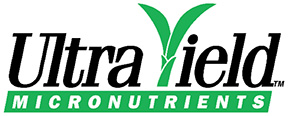ABSTRACT
Zinc sulfate (ZnSO4) has traditionally been the "reliable" source of Zn fertilizer but other sources of Zn are also available. Some are derived from industrial by-products, varying from flue dust reacted with sulfuric acid to organic compounds derived from the paper industry. The degree of Zn availability in Zn sources derived from these various by-products is related to the manufacturing process, the source of complexing or chelating agents (organic sources), and the original product used as the Zn source. Many claims are made regarding the relative efficiency of traditional inorganic Zn fertilizers and complexed Zn sources. The objective of this greenhouse study was to determine the availability coefficients of several commercial Zn fertilizer materials (organic and inorganic) which are commonly used to correct Zn deficiencies in soils. We evaluated the dry matter production, total Zn uptake, and Zn concentration in corn plants fertilized with six different commercial Zn fertilizers. The sources included three granular inorganic Zn sources, two granular organically complexed Zn sources, and liquid ZnEDTA. The soil was low in available Zn (AB-DTPA Zn = 0.48 mg kg-1) and limed to a pH of 7.2. The Zn fertilizers were added to 5 kg pots at rates equivalent to 0, 0.5, 1, 2, 4, and 8 lb Zn A-1 (0, 0.21, 0.42, 0.84, 1.68, and 3.36 mg Zn kg-1 of soil). The ZnLignosulfonate, ZnSO4, and ZnEDTA were always the most effective materials in supplying the plant's needs. The relative availability coefficients (RAC) of these three materials ranged from 70 to 100%, depending on plant parameter measured. The ZnOxysulfate, with 55% water solubility, also performed well with a RAC from 48 to 69%. The lower water soluble materials (ZnOxysulfate, 26% water soluble and ZnSucrate, 1% water soluble) were least effective with RAC values ranging from -12 to 25%. When comparing all sources, water solubility was the primary factor governing the performance of Zn fertilizers. High water solubility is required if a Zn fertilizer is going to be effective in meeting the plant's Zn needs. Zinc ions that are reacted with an organic complexing agent does not guarantee the resulting fertilizer will perform like a true chelate and have a high plant availability. If the end product is not highly water soluble, it will be very inefficient in supplying Zn to the plant. These results confirm our previous research where we concluded that a Zn fertilizer must be from 40-50% water soluble to be an effective Zn source.
CONCLUSIONS
Water-solubility is the primary factor that affects Zn uptake andavailability, not total Zn content or organic complexation in granular Zn fertilizers. Amrani et al. (1997 and 1999) concluded that a 50% watersoluble Zn source was required to be effective, and Mortvedt (1992) concluded that 40% is required. Plants fertilized with low water-soluble Zn sources (i.e. ZnSuc [<1% water-soluble], and ZnOx26 [26% water-soluble]) had reduced dry matter production, Zn concentration, and Zn uptake values, as compared with the higher water-soluble Zn sources (ZnEDTA, ZnSO4, ZnLigno, and ZnOx55). The highly water-soluble Zn sources also had higher RAC values when compared to the low watersolubility materials (i.e. ZnOx26 and ZnSuc). The Zn uptake and concentration results followed similar trends except the plants were able to utilize substantially more Zn from ZnEDTA, relative to the other granular Zn sources, which was probably due to luxury consumption.
When considering all parameters measured and the visual symptoms observed, the Zn sources evaluated can be separated into three groups. The ZnEDTA, ZnLigno, and ZnSO4 were always very efficient in supplying Zn to the plants. The ZnOx55 was less effective, but seemed to supply enough Zn to meet the crops needs, but Zn deficiency symptoms were visible at 22 days after planting (Photos 1 and 2). The ZnOx26 and ZnSuc were relatively ineffective in supplying Zn to the plant. These results confirm the need for high Zn water-solubility (>40-50%) of the Zn source to be an effective Zn fertilizer on alkaline soils.
Complexed Zn sources did not perform as well as a true Zn chelate (i.e. ZnEDTA) with respect to Zn concentration and uptake; although the highly water-soluble ZnLigno, ZnSO4, and ZnEDTA were effective in producing dry matter (Photos 3 and 4; Table 4). Zinc uptake was greater for ZnEDTA compared to the complexed Zn sources (i.e. ZnSuc and ZnLigno; Table 4). Micronutrients can be complexed with other \"complexing agents\" than those described in this paper. However, regardless of the \"complexing agent\" the most important factor to consider is the resulting water-solubility of the micronutrient product. The results of this study have shown that just because a micronutrient is reacted with an organic complexing agent, it does not bestow chelate characteristics on the resulting product.
True chelates are typically more effective at delivering micronutrients to the plant root. The result of this increased effectiveness is reduced application rate requirements. Results from previous work, as well as those of the current study, suggest that ZnEDTA can be 2 to 5 times more effective at delivering Zn to the plant compared to the other water-soluble sources we studied. The organic complexes used in this experiment were not more effective than inorganic ZnSO4. When RAC values of ZnSO4 and ZnLigno are compared there is little evidence to suggest that any more than a 1:1 effectiveness ratio exists between these two sources (Tables 4 and 5). The other organic complex, ZnSuc, performed poorly compared to all other Zn sources. The ZnSuc source has a low Zn watersolubility watersolubility (<0.5%) and its effectiveness was minimal.
Photo 5 is a visual comparison of ZnEDTA 0.5 lb A-1 and ZnSO4 4 lb A-1 (i.e. 1:8 Zn ratio). Based on this photo and the results presented in this study it is clear that ZnEDTA, a true metal chelate, is more effective at delivering Zn to the plant. Photo 6 compares ZnLigno with ZnSO4 at a 1:8 ratio. Visual observation, statistical analysis, and RAC estimation confirm that the complexed Zn sources do not perform similarly to chelates and ZnLigno is equally as effective as ZnSO4.
